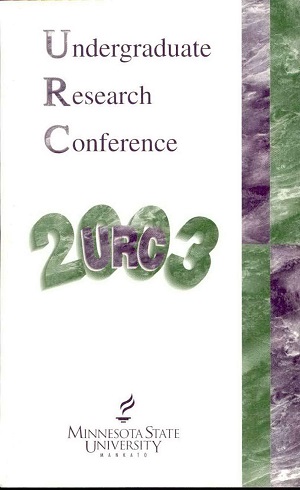The Effects of Solar Ultraviolet-B-Radiation on Growth and Photosynthesis of Avena sativa
Location
CSU
Student's Major
Biological Sciences
Student's College
Science, Engineering and Technology
Mentor's Name
Christopher T. Ruhland
Mentor's Department
Biological Sciences
Mentor's College
Science, Engineering and Technology
Description
We examined the influence of solar ultraviolet-B-radiation on Avena saliva (oat), an agronomical crop species native to ' Minnesota. Response of crop species to UV-B has raised concern among scientists due to the future uncertainty of stratospheric ozone depletion. We grew 20 A. sativa plants under wire frames covered in either aclar filters, which transmit most UV-B, or mylar filters, which absorbs most UV-B. Plants were grown from early spring to late summer while obtaining quantum yield of photosynthesis measurements with a modulated flourometer at 14-day intervals. Plants were harvested at the end of summer and aboveground biomass was recorded. A. sativa plants grown under near ambient UV-B had 17% less aboveground biomass and leaves were 8% shorter than plants grown under reduced UV-B. Quantum yield measurements of photosynthesis were 16% lower in plants grown under nearambient UV-B, which may partially explain reductions in growth. While this data has shown the adverse effects of solar UV-B on photosynthesis and growth of A. sativa, more research is needed to elucidate underlying mechanisms responsible for these observed reductions.
The Effects of Solar Ultraviolet-B-Radiation on Growth and Photosynthesis of Avena sativa
CSU
We examined the influence of solar ultraviolet-B-radiation on Avena saliva (oat), an agronomical crop species native to ' Minnesota. Response of crop species to UV-B has raised concern among scientists due to the future uncertainty of stratospheric ozone depletion. We grew 20 A. sativa plants under wire frames covered in either aclar filters, which transmit most UV-B, or mylar filters, which absorbs most UV-B. Plants were grown from early spring to late summer while obtaining quantum yield of photosynthesis measurements with a modulated flourometer at 14-day intervals. Plants were harvested at the end of summer and aboveground biomass was recorded. A. sativa plants grown under near ambient UV-B had 17% less aboveground biomass and leaves were 8% shorter than plants grown under reduced UV-B. Quantum yield measurements of photosynthesis were 16% lower in plants grown under nearambient UV-B, which may partially explain reductions in growth. While this data has shown the adverse effects of solar UV-B on photosynthesis and growth of A. sativa, more research is needed to elucidate underlying mechanisms responsible for these observed reductions.




